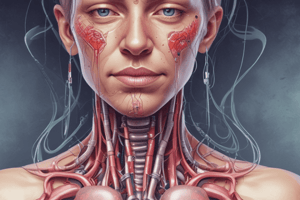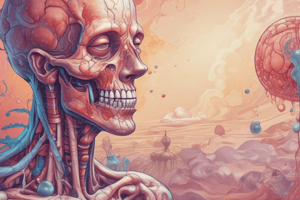Podcast
Questions and Answers
Which of the following is a significant clinical sign of epiglottitis?
Which of the following is a significant clinical sign of epiglottitis?
- Ill-appearing with drooling (correct)
- Coughing with phlegm
- Rapid breathing without distress
- Increased appetite
What is the preferred imaging method for diagnosing pleural effusion?
What is the preferred imaging method for diagnosing pleural effusion?
- Ultrasound of the heart
- CT scan of the abdomen
- Chest X-ray (correct)
- MRI of the thorax
What is the recommended treatment for a massive pleural effusion?
What is the recommended treatment for a massive pleural effusion?
- Immediate bronchoscopy
- Oxygen therapy only
- Intravenous fluid administration
- Therapeutic thoracentesis (correct)
Which condition would most likely require tube thoracostomy?
Which condition would most likely require tube thoracostomy?
What is a common cause of spontaneous pneumothorax?
What is a common cause of spontaneous pneumothorax?
What characteristic finding on a lateral neck film is indicative of epiglottitis?
What characteristic finding on a lateral neck film is indicative of epiglottitis?
In the context of pleural effusion management, which procedure is indicated if a patient is symptomatic at rest?
In the context of pleural effusion management, which procedure is indicated if a patient is symptomatic at rest?
Which microorganism is not commonly associated with the etiology of epiglottitis?
Which microorganism is not commonly associated with the etiology of epiglottitis?
What crucial management step should be taken if a pneumothorax is suspected due to a tension pathology?
What crucial management step should be taken if a pneumothorax is suspected due to a tension pathology?
According to Light's criteria, which feature is used to differentiate between transudative and exudative pleural effusions?
According to Light's criteria, which feature is used to differentiate between transudative and exudative pleural effusions?
Flashcards are hidden until you start studying
Study Notes
Epiglottitis
- Historically a childhood disease, now increasingly observed in adults due to factors like vaccination and decreased childhood incidence.
- Etiological agents include Staphylococcus, Streptococcus, and Haemophilus influenzae.
- Diagnosis confirmed through lateral neck x-ray displaying "thumbprint" sign; clinical diagnosis considers signs such as stridor, dysphagia, and drooling.
- Characteristic patient appearance includes protruding chin (like "smelling flowers").
- Treatment focus includes airway management, corticosteroids, nebulized vasoconstrictor (often racemic epinephrine), and intravenous antibiotics (third-generation cephalosporins) alongside humidified oxygen.
Pleural Effusion
- Defined as fluid accumulation between visceral and parietal pleura.
- Diagnosis primarily through chest X-ray assessment.
- Management involves treating the underlying cause; therapeutic thoracentesis indicated if symptomatic at rest.
- Fluid samples sent for cytology to assist in determining cause.
- In cases of massive or severe effusion, tube thoracostomy recommended.
- Light's criteria used to evaluate and classify the effusion.
Pneumothorax (PTX)
- Can be classified as spontaneous or traumatic in origin.
- Management options vary from conservative approaches to tube thoracostomy based on severity.
- Caution against mechanical ventilation without prior tube thoracostomy, as it may lead to tension pneumothorax.
- Conservative treatment preferred for very small pneumothorax, considering factors such as acute onset and diffuse involvement, with severe hypoxia being a critical indicator.
- Common causes include pneumonia, sepsis, and aspiration phenomena.
Epiglottitis
- Historically a pediatric condition, now increasingly observed in adults due to vaccination and other factors.
- Common pathogens include Staphylococcus, Streptococcus, and Haemophilus influenzae.
- Diagnosis typically involves a lateral neck X-ray, often revealing a "thumbprint" sign.
- Clinical signs include stridor, dysphagia, drooling, and a characteristic posture with the chin extended (resembling smelling flowers).
- Treatment focuses on airway management, corticosteroids, nebulized vasoconstrictors (usually racemic epinephrine), antibiotics (typically third-generation cephalosporins), and humidified oxygen.
Pleural Effusion
- Defined as the accumulation of fluid between the visceral and parietal pleura of the lungs.
- Diagnosis primarily achieved through a chest X-ray.
- Management involves addressing the underlying cause of the effusion.
- If patient is symptomatic at rest, therapeutic thoracentesis is indicated, with fluid sent for cytology to aid in diagnosis.
- Tube thoracostomy required for massive or severe cases.
- Light's criteria helps differentiate between transudative and exudative pleural effusions.
Pneumothorax (PTX)
- Can occur spontaneously or due to trauma.
- Management can be conservative for small PTX; larger cases may require tube thoracostomy.
- Mechanical ventilation should be avoided unless tube thoracostomy is in place to prevent tension physiology.
- Common causes include pneumonia, sepsis, and aspiration, often leading to acute onset and severe hypoxia.
Studying That Suits You
Use AI to generate personalized quizzes and flashcards to suit your learning preferences.




